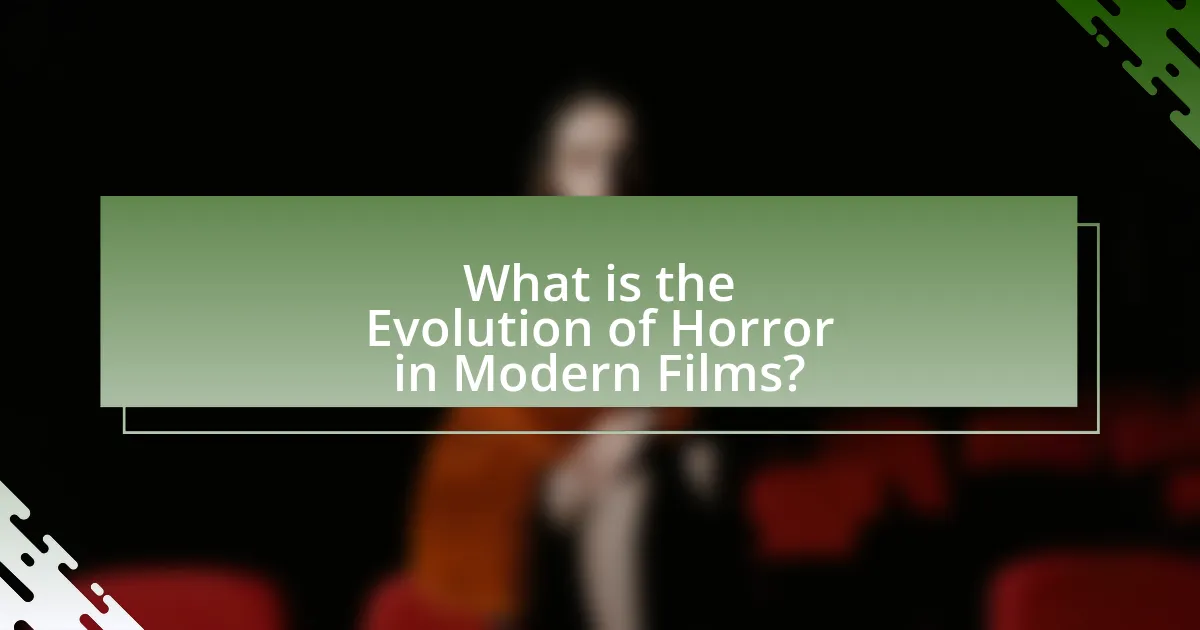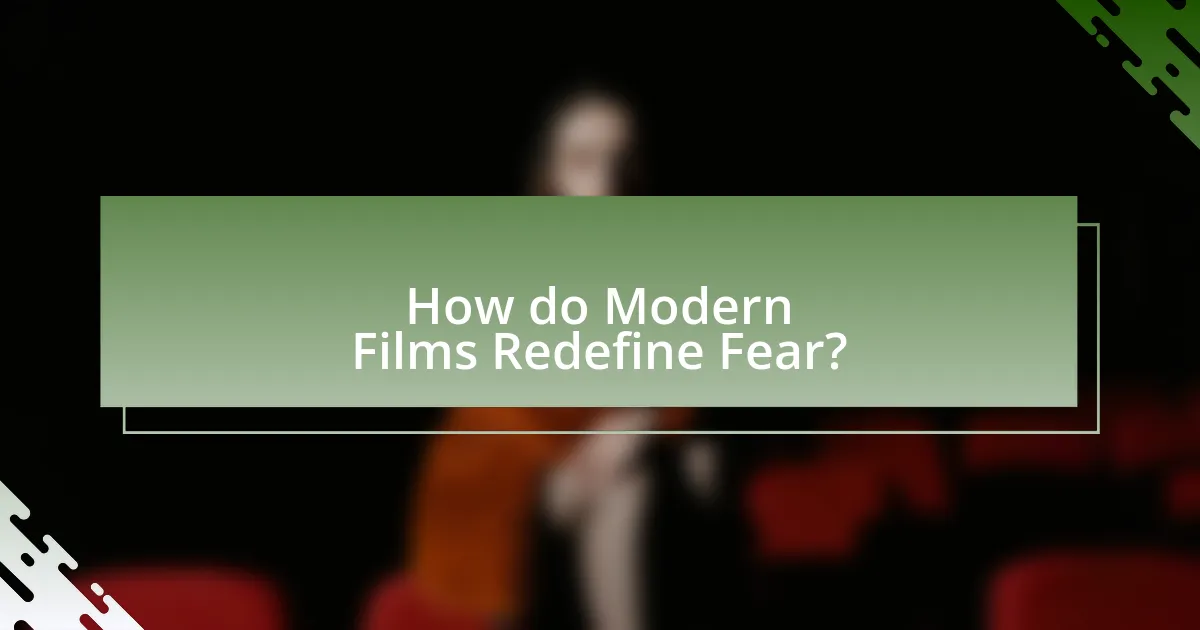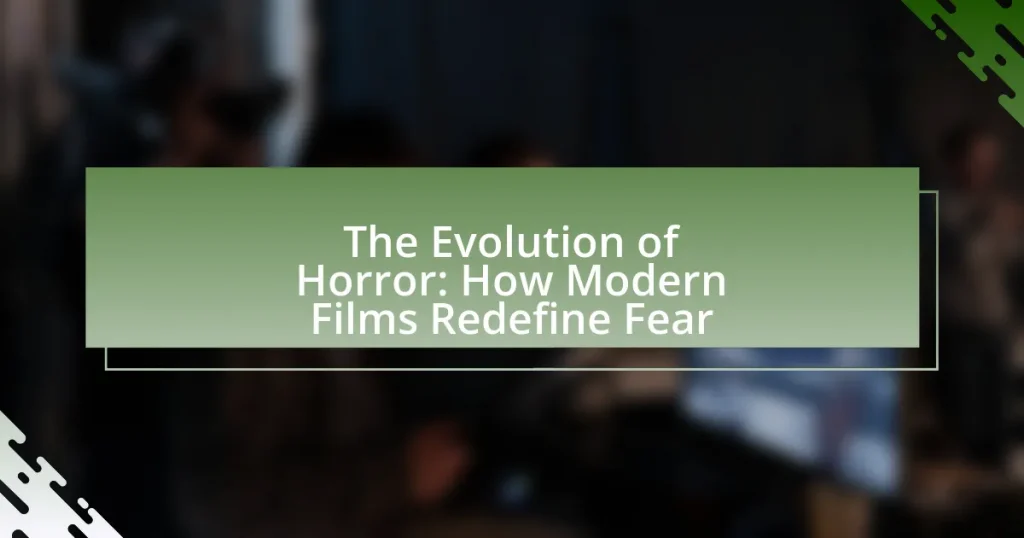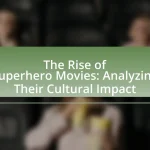The article examines the evolution of horror in modern films, highlighting a shift from traditional supernatural elements to psychological and socially relevant themes. It discusses how historical events and societal fears have influenced horror narratives, leading to a focus on character development and emotional depth. Key characteristics of contemporary horror, such as innovative storytelling techniques and the impact of technology, are explored, along with the role of cultural representation and diverse voices in reshaping the genre. The article also addresses emerging trends and practical tips for engaging with modern horror films, emphasizing the importance of understanding context and enhancing the viewing experience.

What is the Evolution of Horror in Modern Films?
The evolution of horror in modern films reflects a shift from traditional tropes to more psychological and socially relevant themes. Initially, horror films relied heavily on supernatural elements and physical monsters, as seen in classics like “Psycho” (1960) and “The Exorcist” (1973). However, contemporary horror has increasingly focused on psychological terror and societal issues, exemplified by films like “Get Out” (2017), which addresses racial tensions, and “Hereditary” (2018), which explores family trauma. This transition is supported by the rise of independent filmmakers who prioritize character development and emotional depth, leading to a more nuanced portrayal of fear that resonates with modern audiences. The success of these films at the box office and in critical reviews indicates a significant shift in audience expectations and the genre’s direction.
How has the definition of horror changed over time?
The definition of horror has evolved from a focus on supernatural elements and Gothic themes to a broader exploration of psychological and societal fears. Historically, early horror literature, such as Mary Shelley’s “Frankenstein” (1818), emphasized the terror of the unknown and the monstrous, often rooted in folklore and mythology. As society progressed, particularly in the 20th century, horror began to reflect contemporary anxieties, such as the fear of technology and the breakdown of social order, as seen in films like “Psycho” (1960) and “Night of the Living Dead” (1968).
In recent years, horror has increasingly incorporated psychological elements, emphasizing character-driven narratives and moral dilemmas, as exemplified by films like “Get Out” (2017), which critiques racial tensions. This shift indicates that modern horror not only seeks to frighten but also to provoke thought and discussion about real-world issues, showcasing its adaptability to cultural changes and societal fears.
What historical events influenced the evolution of horror films?
The evolution of horror films has been significantly influenced by historical events such as World War I, the Great Depression, and World War II. World War I introduced themes of trauma and existential dread, reflected in films like “The Cabinet of Dr. Caligari” (1920), which showcased psychological horror and the impact of war on the human psyche. The Great Depression led to a rise in horror films that explored societal fears and anxieties, exemplified by “Frankenstein” (1931), which mirrored the public’s fear of technological advancement and loss of control. World War II further shaped horror by incorporating elements of the supernatural and the grotesque, as seen in “Night of the Living Dead” (1968), which addressed fears of societal collapse and the unknown. These events collectively contributed to the thematic depth and complexity of horror films, reflecting the cultural and psychological landscape of their times.
How have societal fears shaped horror narratives?
Societal fears have significantly shaped horror narratives by reflecting and amplifying the anxieties of the time. For instance, during the Cold War, horror films often depicted themes of invasion and paranoia, as seen in movies like “Invasion of the Body Snatchers,” which mirrored fears of communism and loss of identity. Similarly, contemporary horror narratives frequently address issues such as climate change and technological dependence, as evidenced in films like “Get Out,” which explores racial tensions and societal divisions. These narratives serve as a lens through which audiences can confront and process their fears, making horror a powerful commentary on societal issues.
What are the key characteristics of modern horror films?
Modern horror films are characterized by psychological depth, social commentary, and innovative storytelling techniques. These films often explore complex themes such as trauma, mental illness, and societal fears, moving beyond traditional jump scares to create a more immersive and thought-provoking experience. For instance, films like “Get Out” and “Hereditary” utilize character-driven narratives that reflect contemporary issues, such as racism and family dynamics, thereby resonating with audiences on a deeper level. Additionally, modern horror frequently employs advanced cinematography and sound design to enhance tension and atmosphere, as seen in “A Quiet Place,” where silence becomes a crucial element of suspense. This evolution in horror reflects a shift towards a more nuanced understanding of fear, making it relevant to current societal contexts.
How do modern horror films differ from classic horror films?
Modern horror films differ from classic horror films primarily in their approach to storytelling and the use of technology. Classic horror films often relied on suspense, atmosphere, and psychological tension, utilizing practical effects and limited special effects to evoke fear. In contrast, modern horror films frequently incorporate advanced CGI, jump scares, and a focus on graphic violence, which can create a more visceral experience for the audience. For example, films like “The Conjuring” and “Hereditary” utilize contemporary techniques to explore deeper psychological themes and societal issues, reflecting changes in audience expectations and cultural contexts. This evolution highlights a shift from the subtlety of classic horror to the explicitness often found in modern narratives.
What themes are prevalent in contemporary horror cinema?
Contemporary horror cinema prominently features themes of psychological trauma, societal fears, and the supernatural. Psychological trauma is often explored through characters grappling with past experiences, reflecting real-world issues such as mental health and abuse. Societal fears manifest in narratives addressing topics like technology, climate change, and political unrest, highlighting collective anxieties. The supernatural remains a staple, with films utilizing folklore and mythology to evoke fear and explore existential questions. These themes resonate with audiences, as they reflect current societal issues and personal struggles, making contemporary horror both relevant and impactful.

How do Modern Films Redefine Fear?
Modern films redefine fear by incorporating psychological elements, social commentary, and innovative storytelling techniques that resonate with contemporary audiences. Unlike traditional horror films that relied heavily on jump scares and supernatural elements, modern horror often explores deeper themes such as mental illness, societal issues, and existential dread. For instance, films like “Get Out” and “Hereditary” utilize real-world anxieties and personal trauma to evoke fear, making the experience more relatable and impactful. This shift reflects a broader understanding of fear as not just a visceral reaction but as a complex emotional response influenced by cultural and psychological factors.
What techniques do filmmakers use to evoke fear in audiences?
Filmmakers use techniques such as suspense, sound design, and psychological manipulation to evoke fear in audiences. Suspense is created through pacing and the gradual revelation of information, which keeps viewers on edge. Sound design, including unsettling music and sudden loud noises, heightens tension and can trigger instinctive fear responses. Psychological manipulation involves tapping into deep-seated fears and anxieties, often through relatable characters and situations, making the horror feel personal and immediate. These techniques are supported by research indicating that suspenseful narratives and effective soundscapes significantly enhance emotional engagement and fear responses in viewers.
How does sound design contribute to the horror experience?
Sound design significantly enhances the horror experience by creating an immersive atmosphere that heightens tension and evokes fear. The use of unsettling sound effects, such as creaking doors, whispers, and sudden loud noises, triggers instinctual responses in viewers, making them feel more vulnerable. Research indicates that sound can influence emotional reactions; for instance, a study published in the Journal of Experimental Psychology found that specific sound frequencies can induce feelings of anxiety and discomfort. This manipulation of auditory elements not only amplifies suspense but also deepens the psychological impact of horror narratives, making sound design a crucial component in modern horror films.
What role does cinematography play in creating tension?
Cinematography plays a crucial role in creating tension by utilizing techniques such as framing, lighting, and camera movement to evoke emotional responses. For instance, close-up shots can intensify a character’s fear or anxiety, while low-key lighting can create an ominous atmosphere that heightens suspense. Research indicates that specific camera angles, like high angles, can make characters appear vulnerable, further amplifying tension. Additionally, rapid camera movements or sudden cuts can disorient viewers, contributing to a sense of urgency and fear. These techniques are foundational in modern horror films, as they manipulate visual elements to engage the audience’s emotions and enhance the overall experience of fear.
Why are psychological elements important in modern horror?
Psychological elements are important in modern horror because they tap into the audience’s fears and anxieties, creating a more immersive and relatable experience. By focusing on the mental and emotional states of characters, filmmakers can evoke a sense of dread that resonates on a personal level, as seen in films like “Hereditary” and “The Babadook,” which explore themes of grief and trauma. Research indicates that psychological horror can elicit stronger emotional responses than traditional horror, as it engages viewers’ imaginations and personal experiences, making the fear feel more real and immediate. This shift towards psychological depth in horror reflects a broader trend in storytelling that prioritizes character development and emotional complexity, enhancing the overall impact of the genre.
How do psychological horror films differ from traditional horror?
Psychological horror films differ from traditional horror by focusing on the mental and emotional states of characters rather than relying on physical threats or supernatural elements. Traditional horror often emphasizes external dangers, such as monsters or killers, to evoke fear, while psychological horror delves into themes of paranoia, anxiety, and the fragility of the human mind. For example, films like “The Shining” and “Black Swan” explore the psychological breakdown of characters, creating tension through their internal struggles rather than through overt violence or gore. This approach engages viewers on a deeper emotional level, prompting them to confront their own fears and insecurities, which is a hallmark of psychological horror.
What impact do character development and backstory have on fear?
Character development and backstory significantly enhance the emotional impact of fear in horror narratives. When characters are well-developed, audiences form a deeper connection with them, which amplifies the tension and fear experienced during perilous situations. For instance, a character with a traumatic past may evoke sympathy and fear, as viewers understand their vulnerabilities and stakes. Research indicates that audiences are more likely to feel fear when they empathize with a character’s struggles, as demonstrated in films like “Hereditary,” where the family’s backstory intensifies the horror elements. This connection between character depth and fear is crucial in modern horror, as it transforms mere jump scares into profound emotional experiences.

What are the Trends in Modern Horror Films?
Modern horror films are increasingly characterized by psychological depth, social commentary, and innovative storytelling techniques. This trend reflects a shift from traditional jump scares to narratives that explore complex themes such as mental health, societal issues, and existential dread. For instance, films like “Get Out” and “Hereditary” have garnered critical acclaim for their ability to intertwine horror with commentary on race and family trauma, respectively. Additionally, the rise of streaming platforms has facilitated diverse voices in horror, leading to a broader range of styles and perspectives, as seen in works like “The Haunting of Hill House.” These trends indicate a transformation in how horror engages with audiences, moving towards a more nuanced and thought-provoking genre.
How has technology influenced the production of horror films?
Technology has significantly influenced the production of horror films by enhancing visual effects, sound design, and distribution methods. Advanced CGI allows filmmakers to create realistic monsters and terrifying environments that were previously impossible, as seen in films like “The Conjuring” and “It,” which utilize digital effects to amplify fear. Additionally, improved sound technology, such as Dolby Atmos, creates immersive audio experiences that heighten tension and suspense, evident in movies like “A Quiet Place.” Furthermore, the rise of streaming platforms has transformed distribution, enabling horror films to reach wider audiences quickly, as demonstrated by the success of “Bird Box” on Netflix. These technological advancements have redefined how horror stories are told and experienced, making them more impactful and accessible.
What advancements in special effects have changed horror storytelling?
Advancements in special effects, particularly CGI and practical effects, have significantly transformed horror storytelling by enhancing visual realism and emotional impact. The introduction of computer-generated imagery (CGI) allows filmmakers to create lifelike monsters and terrifying environments that were previously impossible, as seen in films like “The Conjuring” and “It.” Practical effects, such as animatronics and makeup, have also evolved, exemplified by the work of artists like Tom Savini in “Dawn of the Dead,” which adds a tangible quality to horror that resonates with audiences. These advancements enable more immersive experiences, allowing viewers to engage with the narrative on a deeper emotional level, thus redefining the boundaries of fear in modern cinema.
How do streaming platforms affect the distribution of horror films?
Streaming platforms significantly enhance the distribution of horror films by providing wider accessibility and immediate availability to diverse audiences. These platforms, such as Netflix and Hulu, allow horror films to reach global viewers without the limitations of traditional theatrical releases, which often restrict access based on geographic location. For instance, Netflix reported that its horror titles, like “Bird Box,” reached over 45 million households within the first week of release, showcasing the rapid audience engagement possible through streaming. Additionally, the algorithms used by these platforms promote horror films to users based on viewing habits, increasing visibility and encouraging consumption. This shift in distribution not only democratizes access to horror films but also allows for a broader range of independent and international horror films to find an audience, which may have struggled in traditional distribution channels.
What role does cultural representation play in modern horror?
Cultural representation plays a crucial role in modern horror by providing diverse narratives that reflect the experiences and fears of various communities. This representation allows filmmakers to explore themes of identity, trauma, and societal issues, making horror more relatable and impactful. For instance, films like “Get Out” and “The Babadook” utilize cultural elements to address racial tensions and mental health, respectively, demonstrating how horror can serve as a lens for examining real-world anxieties. Furthermore, research indicates that inclusive storytelling in horror not only broadens audience engagement but also challenges traditional genre conventions, leading to innovative and thought-provoking content.
How are diverse voices reshaping horror narratives?
Diverse voices are reshaping horror narratives by introducing unique cultural perspectives and experiences that challenge traditional tropes. This shift allows for a broader exploration of fear, as filmmakers from various backgrounds incorporate their societal issues, folklore, and personal histories into the genre. For instance, films like “Get Out” by Jordan Peele and “The Farewell” by Lulu Wang highlight racial and cultural tensions, transforming horror into a medium for social commentary. This evolution not only diversifies storytelling but also resonates with wider audiences, reflecting the complexities of contemporary society.
What impact does cultural context have on the perception of fear?
Cultural context significantly influences the perception of fear by shaping what individuals find frightening based on societal norms, values, and experiences. For instance, in collectivist cultures, fear may be tied to social harmony and community well-being, leading to heightened anxiety about actions that could disrupt group cohesion. Conversely, in individualistic cultures, fear often centers around personal safety and autonomy, resulting in a focus on threats to the self. Research indicates that horror films reflect these cultural nuances; for example, Japanese horror often incorporates themes of familial duty and societal expectations, while American horror frequently emphasizes individual survival and personal agency. This cultural framing alters not only the types of fears depicted but also the audience’s emotional responses, demonstrating that fear is not universally experienced but is deeply rooted in cultural narratives and contexts.
What can audiences expect from the future of horror films?
Audiences can expect horror films to increasingly explore psychological themes and societal issues, moving beyond traditional jump scares and gore. This evolution is evident in recent films that incorporate elements of social commentary, such as “Get Out,” which addresses racial tensions, and “Hereditary,” which delves into family trauma. The future of horror will likely continue to blend genres, utilizing technology and innovative storytelling techniques to create immersive experiences. For instance, advancements in virtual reality and interactive narratives are set to redefine audience engagement, making horror more personal and impactful.
How might emerging trends redefine the horror genre further?
Emerging trends such as virtual reality, social media integration, and psychological realism are poised to further redefine the horror genre. Virtual reality allows for immersive experiences that place viewers directly in terrifying scenarios, enhancing emotional engagement and fear response. Social media integration enables real-time audience interaction, creating a communal experience that can amplify tension and suspense. Psychological realism, focusing on relatable fears and societal issues, resonates more deeply with contemporary audiences, making horror narratives more impactful. These trends reflect a shift towards personalized and interactive storytelling, as evidenced by the success of VR horror games and films that leverage social media for audience engagement.
What lessons can filmmakers learn from the evolution of horror?
Filmmakers can learn that the evolution of horror emphasizes the importance of cultural context and audience psychology in shaping fear. Historical shifts in horror, such as the transition from classic monsters in the 1930s to psychological thrillers in the 1990s, illustrate how societal fears influence horror narratives. For instance, the rise of slasher films in the late 1970s and early 1980s reflected anxieties about personal safety and moral decay. Additionally, modern horror often incorporates social commentary, as seen in films like “Get Out,” which addresses racial tensions, demonstrating that horror can be a powerful vehicle for exploring contemporary issues. This evolution shows that filmmakers should adapt their storytelling to resonate with current societal fears and values to effectively engage audiences.
What are some practical tips for engaging with modern horror films?
To engage effectively with modern horror films, viewers should immerse themselves in the film’s atmosphere by minimizing distractions and creating a suitable viewing environment. This approach enhances emotional responses and allows for a deeper connection to the film’s themes and scares. Additionally, understanding the context of the film, such as its cultural references and the evolution of horror tropes, can enrich the viewing experience. For instance, many modern horror films incorporate social commentary, which can be appreciated more fully with background knowledge. Engaging with discussions or analyses post-viewing can also provide new insights and interpretations, further enhancing the overall experience.
How can viewers enhance their horror film experience?
Viewers can enhance their horror film experience by creating an immersive environment that amplifies tension and fear. This can be achieved by adjusting lighting to dim settings, using surround sound systems for heightened audio effects, and minimizing distractions during viewing. Research indicates that a darkened room can increase the emotional impact of horror films, as viewers are more likely to engage with the film’s atmosphere and narrative. Additionally, engaging in discussions about the film before and after viewing can deepen understanding and appreciation, as studies show that social interaction enhances emotional responses to horror content.
What should audiences consider when choosing horror films to watch?
Audiences should consider the film’s subgenre, themes, and critical reception when choosing horror films to watch. Different subgenres, such as psychological horror, supernatural horror, or slasher films, evoke distinct emotional responses and cater to varying preferences. Themes like societal issues or personal fears can enhance the viewing experience, making the film more relatable or thought-provoking. Additionally, critical reception, including reviews and audience ratings, can provide insights into the film’s quality and effectiveness in delivering fear, as evidenced by platforms like Rotten Tomatoes, where films with higher ratings often correlate with better storytelling and production quality.




